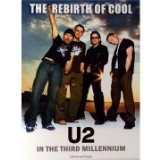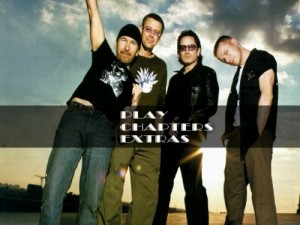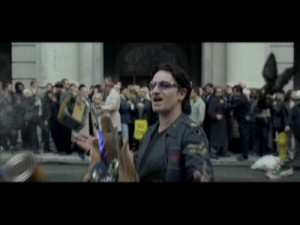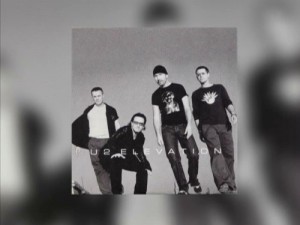U2 was formed in 1976. Back then they were just teenagers figuring out how to play their instruments. But by the mid-80’s, they were one of the best bands in the world. Currently, they have sold more than 145 million albums worldwide and have won 22 Grammy awards. Rolling Stone has them listed as #22 in the greatest artists of all time. They appear frequently at the head of many human rights causes promoting social justice like Bono’s DATA (Debt, AIDS, Trade in Africa) campaign. The Rebirth of Cool: U2 in the Third Millennium takes a look at the band from the failed release of “Pop” to their reborn commercial success in 2000 with “All That You Can’t Leave Behind” and continued superstar greatness in “How to Dismantle an Atomic Bomb” in 2004.
“Pop” was released in March of 1997. It was an attempt at combining techno, dance and eletronica with U2’s traditional hard rock sound. It was unfortunately a failure in the overall scheme of things. It sold the least among any U2 album (1+ million in the US, 2+ million worldwide) and distanced a lot of fans from the band. U2 knew they had to take a different direction. They quite simply had to reapply for the job of the best band in the world.
“All That You Can’t Leave Behind” was released in 2000 and reunited the band with producers Brian Eno and Daniel Lanois who were instrumental in their mid 80’s mega-successes. The album went on to sell over 12 million copies and produce four fantastic singles including “Beautiful Day”, “Elevation” (Tomb Raider soundtrack), Walk On (dedication to Aung San Suu Kyi, a Burmese activist), and “Stuck in a Moment You Can’t Get Out Of” (inspired by the suicide of Michael Hutchence). It broke new barriers as well as went back to through roots.
“How to Dismantle an Atomic Bomb” followed in 2004 and maintained that alternative rock/dance feel that many U2 singles did in the early 90’s. It sold nine million copies worldwide and produced two megahits in “Vertigo” and “Sometimes You Can’t Make it On Your Own” along with several minor hits. Vertigo led to a popular iPod television commercial and became the focus of their Vertigo Tour which led to the second highest grossing tour of all time at a whooping $389 million (only Rolling Stones had a larger tour).
This documentary takes many leading music critics & writers and gets their feelings on the failure of the “Pop” album, how they were re-born and the critical success of the next two albums “All That You Can’t Leave Behind” and “How to Dismantle an Atomic Bomb” and goes in-depth behind the major singles of those albums. In addition, the documentary touches on Bono’s human rights efforts and how is trying to help the world one day at a time.
The documentary is actually pretty decent even if it is a bit narrow in definition. To be honest, I am more familiar with the U2 of the 80’s and early 90’s and kinda stopped being in the loop when Bono went heavy with the politics and world peace talk. Everybody in this mere sixty eight minutes is pretty good and knowledgeable about U2 and their music. In particular, I loved listening to Paul Gambaccini and Lucy O’ Brien (Hey!, Don’t diss Bon Jovi though). The only person I felt that was annoying was Mat Snow who came off as U2’s recent stuff is the best thing they ever done and a lot of their earlier mega successes of the 80’s were the equivalent of rubbish.
The only other odd thing was the complete lack of band cooperation. There is some old footage either borrowed from MTV or old interviews but not very much. It’s mostly these people talking mixed in with bits of videos, concerts and backing tracks. It’s like U2, the third millennium hits on VH1 with a couple of British comics and Chris Jericho. Okay, it’s not that bad. It’s more like Behind the Music I guess and “Pop” would be the drug rehab clinic that they talk about overcoming.
Video
The film is presented in 1.33:1 Fullscreen presentation. It looks okay as you get a lot of documentary shots of people standing around talking mixed in with video clips, concert footage and old interviews. So needless to say, the quality varies. Color looks alright for the most part but unfortunately this falls where most documentaries fall, somewhere smack dab in the middle.
Audio
The audio is provided in Dolby Digital 2.0 English and that’s it. There is a good smattering of music included and some of it sounds pretty good but this is certainly only used as background for the documentary. The dialog is clear as you would expect and there are no confusing accents to be found. The presentation is just very average since there is no involvement from the band. No subtitles are provided.
Special Features
- Special Feature: The Millennium Tours 3:58: A small feature (which probably should have been just added to the documentary) which goes over how U2 went from selling out small arenas to selling out massive stadiums. The same people from the documentary appear here going on about the amount of production that the group endures to give us the end product. It’s no wonder that the touring is now their most profitable product.
- Rebirth of Cool: Interactive Challenge : Twenty five trivia questions about the band U2. Some of the information is in the documentary, some is not. I didn’t do very well, we’ll leave it at that. My only problem with this is that it seemed rather bland, a correct or wrong answer just says “correct” or “wrong” and then moves to the next question. You are given your score at the end with a rating. The correct answers are given but only on a separate part of the feature.
- Contributor Biographies : Biographies of the people in the documentary, their accomplishments and current activities.
- Beyond DVD: This is just basically a quick promo for their website (www.chromedreams.co.uk).
Final Thoughts
It sometimes seems that U2 could make it to the fourth millennium if only we lived that long. They will certainly be around in the next decade making great music and promoting human rights in third world countries. This documentary is a decent little story about their trip since the disastrous “Pop” and into two many multiplatinum over albums that helped to restablish as huge megastars. The disc is alright, with average music and video and hardly any extras to speak of. I have one small question though. Is it just me or on the cover does Edge’s head look way too big for the rest of his body? It really looks photoshopped. And not in the natural way. This dvd will probably get lost in the shuffle, but if you can find it on the cheap and you are a fan, you should probably pick it up.









